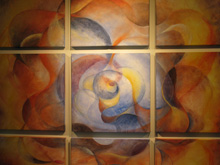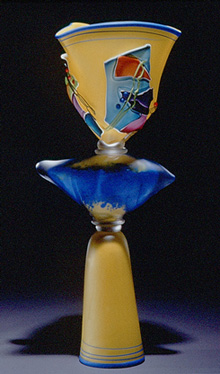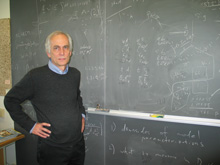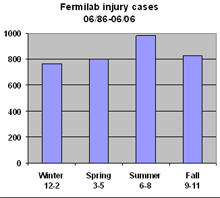 |
Monday, June 26
PARTICLE ASTROPHYSICS SEMINARS WILL RESUME IN THE FALL
3:30 p.m. DIRECTOR'S COFFEE BREAK - 2nd Flr X-over
4:00 p.m. All Experimenters' Meeting - Curia II
Tuesday, June 27
12:00 p.m. Summer Lecture Series - Curia II
Speaker: H. Prosper, Florida State University
Title: The Standard Model and Beyond
3:30 p.m. DIRECTOR'S COFFEE BREAK - 2nd Flr X-over
4:00 p.m. Accelerator Physics and Technology Seminar - Auditorium (Note Location)
Speaker: R. Flora, Fermilab
Title: LHC Quench Protection and Energy Extraction Systems
Announcement:
Heartland Blood Centers will be here for the Fermilab Blood Drive on
June 27 and 28, from 8:00 a.m to 2:00 p.m. in the Wilson Hall Ground
Floor NE Training Room. Appointments can be scheduled on the web
or by calling Diana at x3771.
Click here for a full calendar with links to additional information.
|



Monday, June 26
-Minestroni
-Chicken & Mushroom Cheese Steak
-Baked Chicken Enchiladas
-Pot Roast
-Garden Turkey
-Assorted Slice Pizza
-Szechwan Green Bean with Chicken
The Wilson Hall Cafe accepts Visa, Master Card, Discover and American Express. Wilson Hall Cafe Menu |
 |
Wednesday, June 28
Lunch
-Dominican Beef Salad
-Root Vegetable Vinaigrette
-Orange Cake with Sorbet
Thursday, June 29
Dinner
-Peach and Brie Quesadillas w/Lime Honey Sauce
-Red Snapper Veracruz
-Jicama, Carrot, Green Bean Julienne
-Bourbon Walnut Tart w/Vanilla Ice Cream
Chez Leon Menu
Call x4598 to make your reservation. |


|
 |
Artist reception for Meson and Wilbat: June 28, 5-7 pm
|
The reception for artists Dawn Meson and James Wilbat, whose work is currently on display in the Fermilab Art Gallery, will take place on Wilson Hall's second floor crossover on June 28, at 5 p.m.
|
 |
| "Particle Wave Probability," Dawn Meson Dawn Meson is a San Francisco-based artist whose paintings combine physics principles with artistic interpretation. "Each piece is a small slice of contemporary science fiction landscape--real science visualized through my own imagination," writes Meson. Her work has gained national attention, and has been praised in publications like The New Scientist. |
 |
"3 Piece Sculpture," James Wilbat
James Wilbat has been working with glass sculpture for over 25 years. He uses a long metal rod to pull material from a vat of molten crystal, then layers it to create his sculptures. |
|
|
|
|
|
What's on your chalkboard?
|
 |
| Theoretical physicist Paul Mackenzie uses a mathmatical framework called lattice gauge theory to decode unknown properties of quarks from experimental data. |
|
|
Theoretical physicist Paul Mackenzie was explaining what his calculations are good for to a colleague from Computing Division when he scribbled this list of particle pairings on his chalkboard. As a lattice gauge theorist, Mackenzie works with something called the Cabibbo-Kobayashi-Maskawa matrix, a set of numbers that describe properties of the six flavors of quark when they couple with one another. Lattice gauge theory allows Mackenzie to use real measurements of particles containing quarks to determine properties of the quarks themselves.
The two-and-a-half columns of letters in the middle of Mackenzie's chalkboard represent some of the pairs of quarks in the CKM matrix. The bottom two entries, for example, correspond to the Bs meson mixing results CDF and DZero found last April. Mesons are particles that consist of a quark and anti-quark paired together. They don't last very long--the particles annihilate after perhaps a trillionth of a second--but that's long enough to measure some of their properties. "You don't see them often in ordinary matter, but they are produced like crazy in [high-energy] particle collisions," Mackenzie said.
Identifying all the elements of the matrix, and increasing the precision of those measurements, will give us clues that could lead us to a more fundamental theory of the universe. "There are existing measurements for all the CKM elements and now the job is to make them as precise as possible," Mackenzie said. By filling in the gaps in the matrix, Mackenzie hopes to learn enough about the properties of quarks "to see if we can find evidence for deviations from the Standard Model," Mackenzie said.
--Jennifer Lauren Lee
|

SLAC Press Release,
June 22, 2006:
Physicists size up the 'unitarity triangle'
B factory experiments at the Department of Energy's Stanford Linear Accelerator Center (SLAC) and at the High Energy Accelerator Research Organization (KEK) in Japan have reached a new milestone in the quest to understand the matter-antimatter imbalance in our universe.
Experimenters have leaped from inference to direct knowledge of the proportions of the B unitarity triangle. Not just a simple geometric shape, this triangle summarizes knowledge of the rare processes that contribute to the universe's partiality for matter over antimatter.
Read More
|

CERN Press Release,
June 23, 2006:
CERN confirms LHC start-up for 2007
Geneva, 23 June 2006. First collisions in the Large Hadron Collider (LHC)
will happen in November 2007, said LHC project leader Lyn Evans at the
137th meeting of the CERN[1] Council held in Geneva today. A two month
run in 2007, with beams colliding at an energy of 0.9 TeV will allow the
LHC accelerator and detector teams to run-in their equipment ready for a
full 14 TeV energy run to start in Spring 2008.
Read More
|
|  |

| Summer injury peak |
 |
| Seasonal injuries from 1986 to 2006. |
Based on 20 years of data, summer is the peak season for occupational injuries at Fermilab. The summer average is 49 cases, which is 23 percent greater than the combined average for winter, spring and fall. About 10 percent of the increase is due to wasp stings, 6 percent from mechanical skin injuries and 3 percent from burns. Wasp stings have an obvious summer connection, but what about the lacerations and burns? The answer is not apparent from the accident descriptions. Something about the summer season seems to allow workers to come into more frequent contact with sharp edges and hot/cold items. Perhaps construction, installation and maintenance activities tend to be scheduled more often during this time of year. One aspect to consider is that lighter clothing offers less protection from inadvertent contact.
Here are some suggestions for dealing with Fermilab's summer injury spike:
Inspect places where wasps build nests. If activity is observed, determine whether contact can be completely avoided by modifying or delaying the task. If not, the safest thing to do is kill the insects.
As part of your pre-work review, note locations of sharp edges and hot/cold surfaces and materials. Also, wear the right type of clothing. Keep in mind that shorts and T-shirts do not offer a lot of protection against inadvertent skin contact.
Safety Tip of the Week Archive
|


|
On her way to Wilson Hall, AD's Jean Slaughter snapped this picture of prairie shooting star flowers, also known as Dodecatheon meadia.
(Click image for larger version.)
|
|


Fermilab Barnstormers
The Fermilab Barnstormers will have a set of trainer airplanes available to fly every Wednesday at noon, at the Model Airplane field across from the Pioneer Cemetery (rain date on Thursday). Come try your hand at flying models and learn what our hobby can offer. We will sell tickets at each session for a July raffle of a radio controlled aircraft. For further information, please contact Jim Zagel, x4076, or Rick Mahlum, x4316.
Scottish Country Dancing
Scottish Country Dancing will meet Tuesday, June 27, in Ramsey Auditorium in Wilson Hall. Instruction begins at 7:30 p.m. and newcomers are always welcome. Most dances are fully taught and walked through, and you do not need to come with a partner. Dancing will continue in the Auditorium through the summer. Info at 630-840-8194, 630-584-0825 or folkdance@fnal.gov.
Housing Assignments for Fall 2006 and Spring 2007
The Fermilab Housing Office is now taking requests for houses, apartments,
and dormitory rooms for Fall 2006 and Spring 2007. Since there will be a
large influx of experimenters, and requests are anticipated to be in excess of our
available facilities, you are urged to submit your request for reservations to the
Housing Office by Monday, July 3, 2006. Requests can be made for
any period and need not commence on any particular date. Individual housing requests can be made by using our online housing request form,
but requests for multiple housing units are best handled by direct email to housing@fnal.gov. For further information, please contact the Housing Office at: (630) 840-3777 or email housing@fnal.gov.
Discount Tickets
Discount tickets are available for "110 IN The Shade" at the Cahn Auditorium, August 19 - 27; Disney on Ice, "Monsters, Inc." at the Allstate Arena, September 21 - 24; and Disney Live, Mickey's Magic Show at the Rosemont Horizon, October 12 - 15. Tickets are ordered directly. Registration forms can be found in the Recreation Office or on the
Recreation web page.
Upcoming Activities |
|





